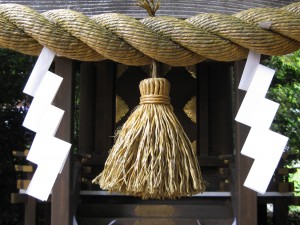There’s a website for religious tolerance that has an explanation about Shinto, along with other world religions:
http://www.religioustolerance.org/shinto.htm
It presents a simple overview which may be of benefit to those coming for the first time to the religion and answers many of the questions that newcomers have. However, it has a bizarre section on ”Origami” which it translates as “Paper of the spirits”, and goes on to say that “This is a Japanese folk art in which paper is folded into beautiful shapes. They are often seen around Shinto shrines. Out of respect for the tree spirit that gave its life to make the paper, origami paper is never cut.”
What?!
There seems to be a clear mistake in translation here, for Ori-gami means ‘Folded paper’.
On the other hand, it does give food for thought. About the shide (white paper zigzags) of Shinto, for instance. The notion of it being sacred and therefore not permitted to cut is interesting.

There’s a curious linguistic relationship between kami=paper and kami=god, spirit. There’s also the apparently false etymological link of kami=upper, superior, above.
Is it just coincidence that we look up to kami, just as we look up to the white paper that flutter on the ropes of Shinto? And if I am not mistaken, some of the goshintai (spirit-body) are in the form of paper, or paper cloth, which at one time was very expensive.
In this case, the kami literally is paper!

Leave a Reply